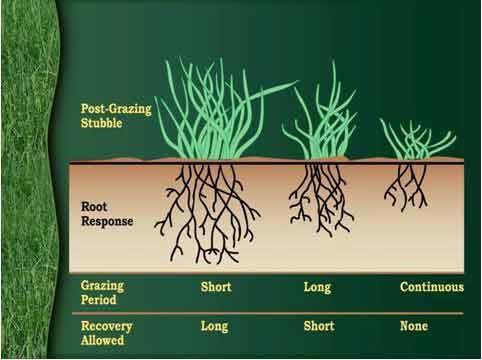Grazing and Pasture Management
Grazing Management Publications
- Skillful Grazing Management of Semiarid Rangelands
- Kansas Grasses
- Grazing Crop Residue
- Multispecies Grazing
- Prairie Dog Management
Grazing Management Links
Pasture Recovery

Pasture Recovery Tips
- First of all provide adequate rest and recovery time. This can be done by not grazing a pasture next year, or implementing a grazing system such as rotational grazing, managed intensive grazing or high density grazing. These systems allow for periods of rest throughout the grazing season.
- Pay attention to range conditions on a regular basis. You have probably heard of the take half/leave half rule. This is not based on height but on the amount of biomass or leaf area. The more severely grazed a plant is, the longer it takes to recover.
- Healthy pastures should also have plant diversity. Grasses provide the main part of the diet, but forbs and legumes provide additional protein and are beneficial to soil health as well.
- It is also important to leave adequate residue. Bare ground does not capture or retain moisture as effectively as ground that is covered by standing plants or plant residue.
- Move from continuous grazing to a more managed grazing system as mentioned above. Continuous grazing is about 30% less efficient than managed grazing when done properly. This can be a challenge, but well worth the change with increased productivity over time.
- Develop a drought management plan. Keep accurate herd records and sell less productive or older cows. A gradual sell off will allow you to last longer through a drought and still let you keep the best cows.
Water Management
Types of Grazing Management & Definitions
1) Management-intensive Grazing (MiG): The thoughtful use of grazing manipulation to produce a desired agronomic and/or animal result. This may include both rotational and continuous stocking depending upon the season.
2) Ultra High Stock Density Grazing or Mob Grazing: A mob is a group of animals. This term is used to indicate a high stock density. This is probably the hottest new grazing strategy. In this animals are allowed to graze small areas at a time and are moved 2 to 6 times a day. This allows for more uniform grazing and causes more uniform distribution of dung, urine and trampling.
3) Continuous stocking: Allowing the animals access to an entire pasture for a long period without paddock rotation. This is the stocking method used by a majority of producers. Although convenient, it results in less forage production and stocking rates compared to previous mentioned methods. It also results in certain areas of pasture being over-grazed while other areas are under-grazed.
4) Rotational Grazing: Rotating livestock from paddock to paddock throughout the grazing season.